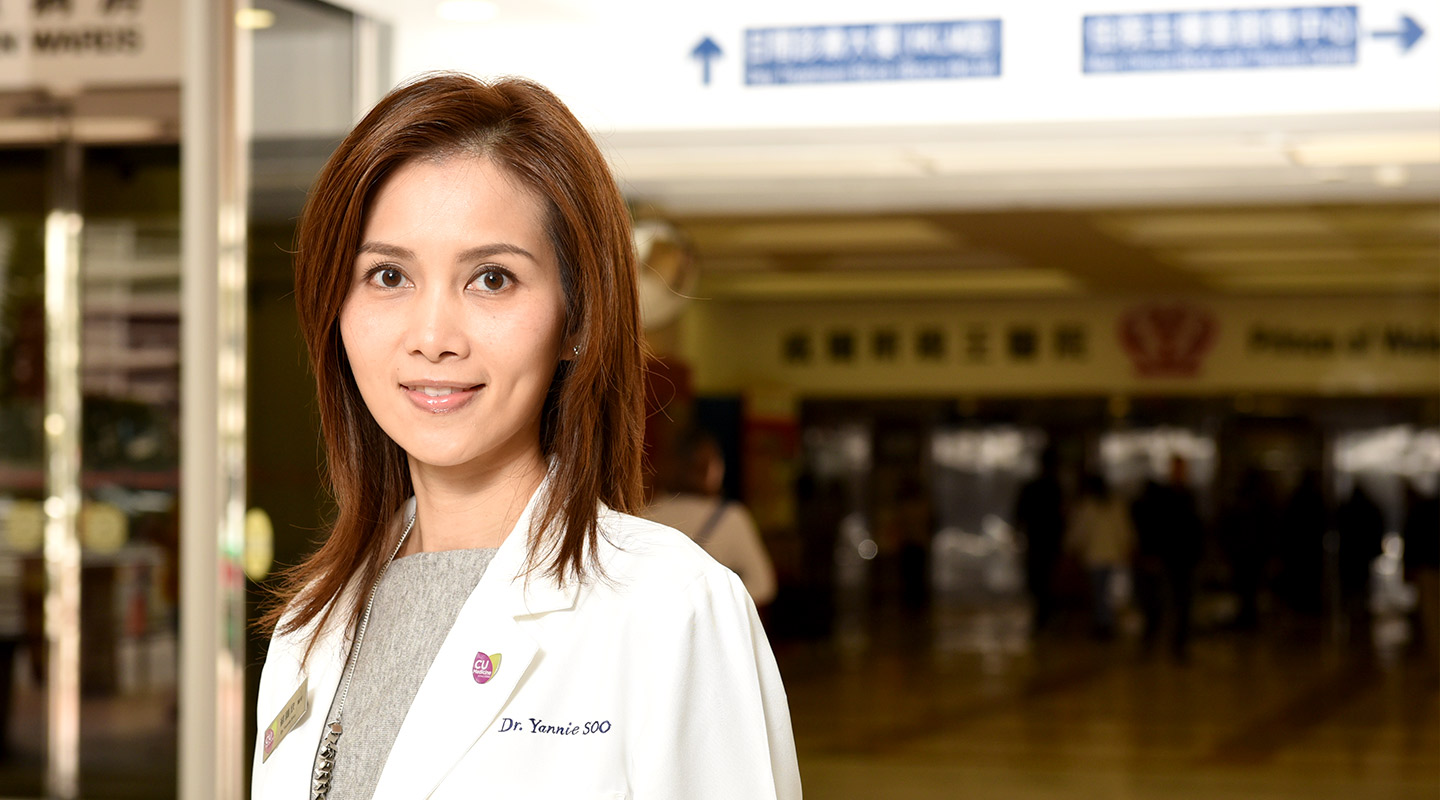Dear readers, With the launch of e-newsletter CUHK in Focus, CUHKUPDates has retired and this site will no longer be updated. To stay abreast of the University’s latest news, please go to https://focus.cuhk.edu.hk. Thank you.
Well-rounded Care
Yannie Soo strikes a perfect balance between work and family

Prof. Yannie Soo
Clinical Professional Consultant and Honorary Assistant Professor
Division of Neurology, Department of Medicine and Therapeutics Faculty of Medicine
What caused you to engage in stroke treatment and research?
I joined Prof. Lawrence Ka-sing Wong’s team on stroke research 10 years ago. His vision and perseverance have been my motivation. Stroke is very common, which may not announce itself but once it has happened, the patient might be paralyzed or disabled. Blood vessel stenosis is the main cause of ischemic stroke. The location of stenosis varies across ethnicity: carotid stenosis is more common among westerners while intracranial stenosis is more common in the Chinese population. Hence, the treatment and medicine that work well on westerners might not work on the Chinese. My research is on better treatment for the Chinese patients.
How does the TeleStroke for 24-hour thrombolysis service benefit patients?
In Hong Kong, over 20,000 stroke patients per year are admitted to hospital for treatment. Neurologists in public hospitals, however, are merely around 60, and these neurologists have to spend time on general clinical services on top of neurological patient care. To have a resident neurologist around the clock is out of the question. The Prince of Wales Hospital (PWH) launched the mobile visual communication system TeleStroke in 2012 to facilitate neurologists' off-site assessment of thrombolysis during non-working hours and to instruct specialist nurses to administer thrombolytic therapy in urgent cases. PWH has recorded a fourfold increase in the number of stroke patients who receive thrombolysis. The public hospitals offering this service have now reached seven. PWH is currently the only hospital in the New Territories East Cluster providing 24-hour telemedicine service. We are lining up the neurologists in our cluster (including PWH, Alice Ho Miu Ling Nethersole Hospital and North District Hospital) to offer telemedicine services to patients in these three hospitals. As more manpower is required for the project, we are negotiating with the Hospital Authority for additional resources.
Young stroke patients have been increasing worldwide. What kind of lifestyle helps prevent this?
A healthy diet and optimal exercise help stabilize blood pressure, blood glucose and blood lipids, which minimize the risk of stroke. Don’t eat too much red meat and processed meat, but eat fresh fruits and vegetables. Note that the latter can’t be replaced by juices. However busy you are, you need to exercise three times a week for better metabolism to prevent blood vessel stenosis. A healthy lifestyle should be acquired as early as possible.

Apart from clinical services, you also need to take part in administration, research and teaching. Which do you enjoy the most?
The experience gained in each position helps me do better in the others, so I’m pleased to take up different positions. I first took up clinical work, and was assigned a teaching role later on. Some complicated diseases encountered have become case studies which help my students apply their medical knowledge. My administrative work in the hospital has enabled me to see what improvement in the system is needed and to improve it gradually. I now spend 70% of my time in research. I hope the findings would help improve diagnoses and enhance treatment effectiveness. For instance, we have just completed a 15-year follow-up study of stroke patients and discovered an increasing number of arrhythmia-induced stroke cases. One reason is fewer patients are willing to take anticoagulant. Then we have to figure out the root of the problem: Is the drug too expensive? Or, are doctors worried about the risk of anticoagulant-associated haemorrhage?
You were in the ‘dirty team’ in 2003. How did it change your life?
I’m glad I was part of it. The battle against SARS is a constant reminder of the insignificance of human beings, who could be very much at the mercy of the bacteria. I’ve learned to seize each day, do whatever matters to me, and cherish my family time.
Working overtime is common among physicians. How do you strike a balance between work and family?
It’s never easy to be a working woman nowadays. Absolute devotion is expected of her in family and at work. I do know what good a full-time mom would do to the family, but I also know that my experience of curing patients and taking on the challenges at work would help my kids understand life better. About two years ago, I was offered a part-time position at CUHK’s Faculty of Medicine. I could therefore remain in my beloved medical field to teach and to do research, and have the energy to take care of my family. Even though my income and career growth are halved as compared to other full-time physicians, I find it worthwhile.
This article was originally published in No. 494, Newsletter in Mar 2017.
Read More: